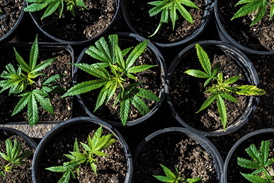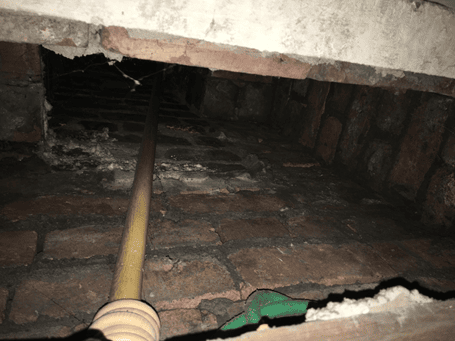Cannabis Cultivations – What to Look Out For.

In this article, Sava student and serving police officer, Christopher Moran, explains the signs to look out for when inspecting property with regards to cannabis cultivations, and what to do if you suspect a property is being used to store or grow cannabis. He also includes an interesting case study from a property inspection where it was evident that cannabis had been grown previously.
Classification and statistics
Cannabis is currently a Class B drug and supply and production of it can result in up to 14 years in prison, an unlimited fine, or both, and possession can result in up to 5 years, an unlimited fine or both.
In 2018/19, seizures of Class B drugs in England and Wales increased by 11% on the previous year, with cannabis accounting for 94% of Class B drugs seized, totalling 108,362 seizures. The increase has been driven by an increase in seizures of herbal cannabis and cannabis plants. In that year, a total of 395,843 cannabis plants were seized, an increase of 12% since 2017/18 when 354,540 plants were seized.[1]

Figure 1 – Summary table from the Home Office
According to reports, 94% of cannabis farms (also known as ‘factories’ or ‘grows’) are located in domestic premises. Therefore, property professionals may encounter evidence suggesting a property is being or has been used as a cannabis farm.
The signs
There are a number of indications that suggest a property may have been used as a cannabis farm in the past or present including:
• Windows blacked out or covered by plastic or heavy fabric, usually hidden by net curtains or blinds so as not to look suspicious from outside.
• Significant garden waste i.e. empty bags of fertiliser, root balls and soil, often around bins outside.
• Holes cut into walls and ceilings for wires and ventilation tubing.
• Plastic sheeting on floors to prevent water and soil from plants going through flooring.
• Floors sodden with water which could be at risk of giving way under foot.
• Old hydroponic equipment left in place.
• Vents and air ducts blocked to prevent the smell of cannabis escaping, thus alerting neighbours.
• Poor detailing to work; not structurally supported; holes knocked into walls and chimneys.
• Insulation on the rafters and roof lining to prevent thermal detection by police helicopters.
• Electricity meters bypassed – cannabis grows require large amounts of electricity for high intensity lights and fans, and meters are often dangerously bypassed.
• Locks on doors and on attic access.
• Condensation and mould issues in the area where the grow previously took place.
• Remnants of cannabis leaves present.
It goes without saying that a live cannabis grow should be easily recognisable by the presence of cannabis plants.


Considerations
If you come across a property you suspect has been or is currently being used to grow cannabis, you should confirm your thoughts in your report for your client and confirm the condition of the property based on your inspection. Although you would normally inspect these elements anyway, you should pay particular attention to the following:
For your safety, you should be aware of the potential for booby traps which may be present to prevent cannabis from being stolen, (although more likely on live grows). This has been known to be as serious as electric wires connected to the mains at entrance points and weapons designed to swing into people walking into rooms. If you find or suspect a booby trap you should not touch anything and leave via the same route you entered.
Have there been any structural changes which require remedy?
Walls, ceilings, chimney breasts etc., may have been altered.
Are the floors and ceilings in good condition?
The floor and ceilings may have been jeopardised by water ingress.
Are the electrics safe?
Some cannabis farms have been discovered due to a fire caused by the abstraction of the electricity supply. Although a condition rating 3 is required where there is no recent electrical safety certificate, you should still view the electrical system and if it appears tampered with or unsafe, record this in your report appropriately.
Could there be damp issues?
If ventilation has been blocked, it may cause condensation issues resulting in damp and mould.
Potential for further criminal activity?
The presence of an old cannabis grow may put some purchasers off and it would be dutiful to advise that if there has been history of a cannabis grow, there is a risk criminal gangs may still believe drugs are in the dwelling.
Issues for legal advisors
Legal advisors should be made aware of the suspicions so they can make necessary enquiries, for example to the current energy supplier regarding outstanding energy bills.
Notifying the police
If the grow is historic then the police may not act on the previous occupant if there is no clear evidence of controlled drugs (hydroponics are also used for growing tomatoes too!). However, it can help the police to know so they can develop intelligence about grows in the area. If you believe you have inspected a property that was previously used to grow cannabis, you can contact your local police on 101 or anonymously via Crimestoppers on 0800 555 111.
If the grow is active and there are live cannabis plants present, then think about your own personal safety as a surveyor. The plants are extremely valuable to someone and they risk a potential prison sentence if they are caught. Leave the property at once via the same route you entered, making sure not to touch anything, get to a safe place, and then call 999.
A case study
During December 2019, whilst conducting a HomeBuyer’s survey with my mentor on a 3-bed terrace in Sheffield, we started to notice unusual signs at the property. In the cellar we noticed the air vents had been carefully blocked and the coal chute completely concreted over. Despite this total lack of ventilation, the timbers showed no signs of excessive dampness. The bottom of the chimney stack had been removed, leaving a poorly supported opening into the chimney, as shown in the figure 1.

Figure 2 – bottom of chimney stack opened.
In the roof space, the rafters had all been covered rather poorly, the floor was covered in plastic sheeting and attempts had been made to fill any ventilation or air gaps with expanding foam, as shown in figures 3 and 4.

Figure 3 – plastic sheeting to the floor, roughly boarded over rafters and expanding foam to fill cracks.

Figure 4 – expanding foam in all the cracks and in the top right of the image around the purlin.
The chimney in the attic also had a hole roughly broken into it with no form of structural support.

Figure 5 – hole in chimney (note the rough hole with no consideration for structural support of the chimney stack).
Using a combination of our surveying knowledge and my experience as a police officer we came to the following conclusions:
- The cellar had been airtight sealed as it had previously been used as a growing space for a cannabis cultivation. Keeping the space airtight prevents the distinctive and strong smell of the plant from being detected by passers-by and neighbours.
- The chimney had been broken into to provide ventilation and allow the strong smells out of the top of the chimney and again avoid detection. This also explained the lack of moisture despite all air bricks and the coal chute being completely sealed.
- In the roof space, the plastic sheeting had been used to prevent water leaking through the plasterboard ceilings, as an average cannabis crop uses a large amount of water to cultivate.
- The chimney had been used to vent out smells and, to a lesser extent, moisture. During the course of growing the cannabis, it most probably contained ventilation piping and a mechanical extraction fan.
- Sealing cracks and vents not only prevents the smell escaping but it also creates a rudimentary level of insulation which helps avoid thermal imaging detection by police helicopters. The need for insulation explained the use of boards over the rafters.
Our conclusions were confirmed when we found a solitary cannabis leaf that had become lodged in the insulation, most likely during the time of the ‘crop’, when the growers harvest the cannabis to sell.

Figure 6 – cannabis leaf located in the insulation
Implications
If the client was to purchase this property, there would be structural issues that would need fixing as well as damage to the vents and the chimney.
There could be long term damp and condensation issues caused by the growing of large amount of plants within the property and the lack of ventilation in the loft could lead to future issues.
If the property was also used for selling drugs, drug users may be inclined to continue to visit the property believing the previous occupiers still lived there. Also, the property may be subject to burglary by criminal gangs attempting to steal other gangs’ cannabis cultivations.
A valuer’s perspective
Sava asked Giles Smith MRICS, Chief Surveyor and Technical Director at SDL Surveying, his thoughts on illegal use of property of this nature and the potential impact on value. Giles explained:
“A lot depends on the nature of the criminal activity going on, and the location.
“Many of these suburban ‘factories’ are in good quality neighbourhoods and badly treated (wiring ‘upgrades’, holes cut in floor and ceilings for H&V ducting, water damage and soil everywhere), but that can be made good. Many farming activities go on completely unseen by the neighbours as the windows are blacked out and the occupiers seldom venture outside. Nobody ever visits the house in daylight and any crop is removed after dark. In other words, in good locations, the neighbours never know. In this case, I would be advising the lender on cost of works and possibly 5-10% off, depending on the area.
“Contrast that with a drug den offering wholesale cash and carry in a poor location, with brief but disruptive visitor behaviour the norm – the area alone may mitigate against mortgage lending, but if it’s in a vaguely saleable area, then that new occupier can look forward to some hassle from undesirable visitors for some time to come, and the property may prove very hard to sell.”
A lender’s perspective
Gary M Epps MRICS, RICS, Head Valuer at Nationwide Building Society, gave us his comments too:
“We don’t have specific policy covering this scenario other than we certainly expect the valuers to flag issues relating to fraud, scheme abuse and illegal activity. Valuers can use our internal suspicious activities reporting facility, and cases where there is suspected, or indeed, actual evidence of criminal activity, then reporting direct to the police is encouraged (accepting that we would not want to put valuers in danger through the reporting of such activity).
“If we were presented with a property that had clearly been used for anything other than legitimate residential use and had been altered accordingly, then depending on the extent of such work we might recommend a decline or a retention to remediate.”
About Chris Moran
Chris is a Sava student studying the Diploma in Residential Surveying and Valuation. He is also a current serving police officer with over 12 years of policing experience, including first-hand experience of finding and dismantling cannabis cultivations and prosecuting the owners. Chris is very interested to hear from any surveyors in the Sheffield area to gain further mentoring experience and also from any prospective future employers. To get in touch with Chris, please email chrismoransurvey@gmail.com
